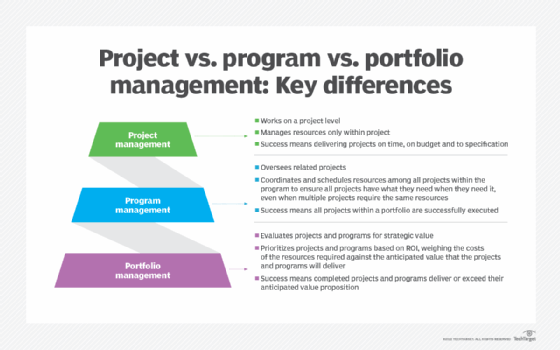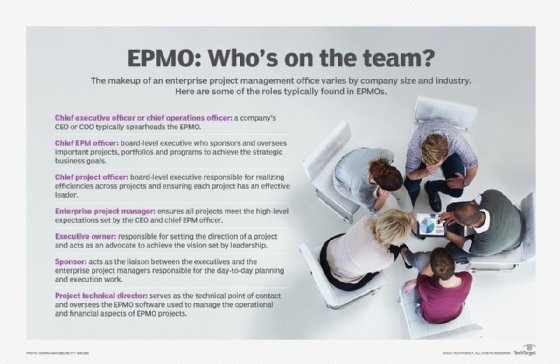enterprise project management office
What is an enterprise project management office (EPMO)?
An enterprise project management office (EPMO) is a department within an organization charged with setting priorities, standards and goals for the organization's portfolio of projects.
The primary responsibility of an EPMO is to set the strategy for how an enterprise's portfolio of projects is managed from start to finish, including planning, prioritization and value realization -- and in doing so -- ensure the company's projects are aligned with its strategic objectives. Its work includes setting project governance rules, establishing process controls, creating key performance indicators for projects and oversight of project technology .
EPMO vs. PMO: What's the difference?
EPMO and project management office, or PMO, are not interchangeable terms, according to the Project Management Institute (PMI). The difference between the two is that PMOs traditionally do not assume a lead role in strategic goal alignment whereas EPMOs do. The traditional PMO tends to be more tactical in approach than an enterprise project management office. To add to the mix (and confusion), sometimes companies will have a project portfolio management office. Ultimately, they all exist to ensure that an organization's projects align with strategy and are successfully completed on time and within budget.
Organizations will determine how each entity is structured. Who a company's project managers report to will depend, in some cases, on company size. For example, it is not uncommon to have a PMO within the company's IT department, with the IT project manager providing lateral guidance on IT projects and reporting to the EPMO.
EPMOs sit outside of a business unit and help executive leadership decide which programs and projects to take on. For that reason, an EPMO usually reports to the C-Suite and strategically guides all the projects within an organization.
Another difference between PMOs and EPMOs: While EPMOs can manage small projects, they are generally used for managing large-scale, complex projects and they typically manage several projects at a time.

Why is an EPMO important?
An EPMO has visibility across the whole organization and can coordinate efforts among business units to ensure projects are aligned and don't conflict. This visibility gives the EPMO the ability to help with demand forecasting and resource planning, which the office sometimes assists with.
EPMOs also can improve communication across an organization because it works directly with a company's executive teams. Indeed, an important responsibility of the EPMO is creating the communication plans for the projects they oversee. The plans clearly define communication channels, assign specific roles, create reporting procedures and guidelines, and designate the types of collaboration that will be used.
In monitoring the organization's portfolio of project's progress, an EPMO also helps different business units stay on track with meeting their goals. According to PMI, employees rely on the EPMO for intake, discovery, planning, prioritization, outcome tracking and ways of working. As characterized by Kara Austin, director of EPMO at the PMI, the EPMO "is a single front door to [project] execution and success with the backing of the C-Suite."
Benefits of an EPMO
Having an EPMO is helpful for setting standards, establishing processes, improving communications and increasing productivity. Perhaps the biggest benefit of an EPMO is that it enables the company to simplify how large, complex projects are managed and carried out, because it works at a strategic level in collaboration with C-suite executives.
It makes it easier to manage several projects at a time, especially if they have similar goals or require similar resources. The office often functions as the glue between departments and provides support, resources and guidance on even the most complex projects. It provides consistency and the ability to leverage best practices to ensure operational efficiency, the PMI said.
Challenges of an EPMO
The challenges of an EPMO are related to the perception that it adds "red tape" or unnecessary processes, according to PMI. But PMI's Austin said EPMOs can mitigate this risk by serving in an advocacy role and building trust through project success.
An EPMO can be a service organization that aligns the business, operations, technology, finance, legal and marketing teams for example, Austin explained. Having a neutral resource at the enterprise level, like the EPMO, leads to partnerships across teams that get things done, she said. Teams are more powerful when the EPMO acts as a shared advocate that hears all viewpoints and focuses on finding the best path forward.
An EPMO might also face challenges when the organization does not follow an agile methodology. When this is the case, there is also often poor resource planning, reduced team efficiency, fragmented output, lack of project visibility and budget overages.
EPMO best practices
Within its own EPMO, the PMI takes an agile-based approach that is responsive to internal stakeholder feedback and promotes cross-functional collaboration. Tailoring ways of working to specific individuals is critical to success, as is using retrospective feedback to facilitate change and continuous improvement, the institute said.
An EPMO should have clearly defined business responsibilities and a structure. It also needs to standardize processes to improve efficiency and productivity with frameworks that spell out responsibilities, accountability and project oversight. An EPMO should also be coaching team members on how to work together effectively and conduct lessons-learned sessions or retrospectives to continuously improve project management.
Here are some other best practices:
- Develop a plan for risk management and scope creep.
- Form good relationships with stakeholders.
- Set relevant KPIs.
- Focus on engaging teams.
- Measure project value.
- Use software that offers dashboards, analytics, automation and ease of use.

EPMO roles and responsibilities
An EPMO is responsible for facilitating the strategic alignment, planning, prioritization and value realization of enterprise-wide projects, product portfolios and activities. It accomplishes this through a team of program and project managers, business analysts and agile experts.
The makeup of an EPMO will vary by company size and industry. Some of the roles typically found in an EPMO include the following:
- Chief executive officer or chief operations officer. Depending on organizational structure, the company's CEO or COO spearheads the EPMO.
- Chief EPM officer. A chief EPM officer is a board-level executive who sponsors and oversees important projects, portfolios and programs to achieve strategic business goals. One of their critical roles is to drive efficiencies and synergies between projects, making sure resources are utilized effectively and that all projects have an effective leader. The chief EPM officer is also in charge of implementing project management methodology, controlling project scope and managing risk.
- Chief project officer. A chief project officer is a board-level executive who has primary responsibility for realizing efficiencies across projects and ensuring each has an effective leader. The CPO also carries out the chosen project management methodology and controls project scope.
- Enterprise project manager. An enterprise project manager is charged with ensuring all projects meet the high-level expectations set by the CEO and CPO. Enterprise project managers don't necessarily get involved with the finite details of all projects.
- Executive owner. All projects require a leader to serve as the voice and champion of the project. The executive owner is responsible for setting the direction of a project and acting as an advocate to achieve the vision set by leadership.
- Sponsor. The sponsor acts as the liaison between the executives and the enterprise project managers responsible for the day-to-day planning and execution work.
- Project technical director. The project technical director serves as the technical point of contact and oversees the EPMO software used to manage the operational and financial aspects of EPMO projects.







